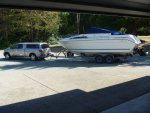I am not new to backing trailers up. But when it comes to boats..i am learning all very quickly. Two weeks ago I diddnt know what engine trim was. Lol
I've only taken my boat out 3 times so far. Loaded the boat...you guessed it..3 times. I've watched tons of YouTube videos and seems many drive onto the trailer.
so. I have a 89 19ft Searay. With a "EZ loader" (yeah right) trailer with rollers. My ramp I've used seems to be on the steeper end vs many I see on videos.
I've managed to drive on but as soon as I let off, I roll back. And seems only way is to leave motor in gear to hold me in place. I considered being out of water too much but seems any less I seem I don't have enough trailer to guide me straight. I considered the rope method but boat seems too heavy to guide it well enough...or unless when one uses a rope method, does trailer need to be lower in the water?
I understand I don't have a video but any suggestions or things to look at when I go back soon.
I will add, the last time lining up was tricky because I parked boat too close to trailer but was still 6ft to the side. I needed a longer attempt to get the boat straight...and by time I got trailer in...another boat parked behind me!!
I've only taken my boat out 3 times so far. Loaded the boat...you guessed it..3 times. I've watched tons of YouTube videos and seems many drive onto the trailer.
so. I have a 89 19ft Searay. With a "EZ loader" (yeah right) trailer with rollers. My ramp I've used seems to be on the steeper end vs many I see on videos.
I've managed to drive on but as soon as I let off, I roll back. And seems only way is to leave motor in gear to hold me in place. I considered being out of water too much but seems any less I seem I don't have enough trailer to guide me straight. I considered the rope method but boat seems too heavy to guide it well enough...or unless when one uses a rope method, does trailer need to be lower in the water?
I understand I don't have a video but any suggestions or things to look at when I go back soon.
I will add, the last time lining up was tricky because I parked boat too close to trailer but was still 6ft to the side. I needed a longer attempt to get the boat straight...and by time I got trailer in...another boat parked behind me!!






















